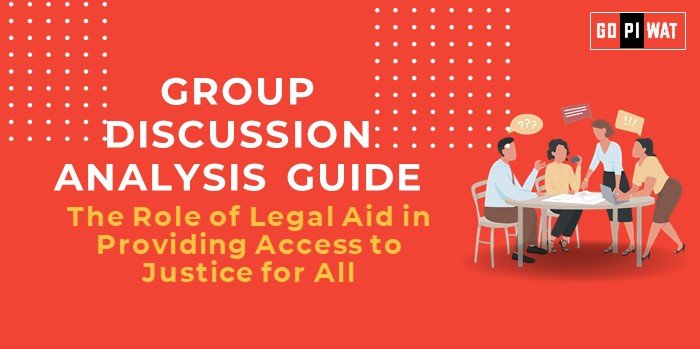📋 GD Analysis Guide: The Role of Legal Aid in Providing Access to Justice for All
🌐 Introduction to the Role of Legal Aid
- ⚖️ Opening Context: Legal aid ensures that justice is not a privilege for the wealthy but a right for all, resonating with the global principle of equality before the law.
- 📜 Topic Background: The concept of legal aid was institutionalized globally with Article 14 of the Universal Declaration of Human Rights (1948). In India, Article 39A of the Constitution emphasizes free legal aid for economically weaker sections. Recently, legal aid gained prominence with initiatives like Lok Adalats and NALSA’s nationwide schemes.
📊 Quick Facts and Key Statistics
- 🌍 Global Legal Aid Access: Only 30% of the world’s population has access to legal aid.
- 💰 India’s Legal Aid Budget: ₹100 crore allocated for FY 2023-24 under NALSA programs.
- 👥 Beneficiaries: Over 1 crore individuals received legal assistance in India in 2023.
- 📂 Pending Cases in India: Over 4 crore cases highlight the necessity of effective legal aid.
👥 Stakeholders and Their Roles
- 🏛️ Government Agencies: Fund legal aid schemes and ensure their implementation through NALSA.
- 📢 NGOs: Provide grassroots-level assistance and awareness.
- ⚖️ Judiciary: Plays a pivotal role in enforcing access to justice.
- 👨👩👧👦 Citizens: Participate in schemes like Legal Aid Clinics for empowerment.
- 🌐 International Organizations: Advocate and monitor adherence to legal aid frameworks (e.g., UNDP).
🏆 Achievements and Challenges
✨ Achievements:
- 📈 Increased Coverage: NALSA served over 1 crore people in 2023, reaching marginalized communities.
- ⚡ Lok Adalats: Disposed of 52 lakh cases in 2023, promoting faster resolution.
- 🤝 Pro Bono Movement: Growing number of lawyers volunteering services.
⚠️ Challenges:
- ❓ Awareness Gaps: Many eligible individuals remain unaware of their rights.
- 💸 Insufficient Funding: Budget constraints affect outreach and quality.
- 👩⚖️ Legal Workforce Shortages: High demand vs. limited trained professionals.
🌏 Global Comparisons
- 🇺🇸 United States: Public defenders face workload challenges despite structured systems.
- 🇿🇦 South Africa: Legal aid access extended to rural areas through mobile courts.
📖 Case Studies:
- 🏛️ India: Delhi State Legal Services Authority’s success with its helpline system.
🗣️ Structured Arguments for Discussion
- ✅ Supporting Stance: “Legal aid has empowered millions by bridging the gap between law and accessibility, ensuring justice for marginalized groups.”
- ❌ Opposing Stance: “The impact of legal aid is undermined by insufficient awareness and inadequate funding, leaving many without effective recourse.”
- ⚖️ Balanced Perspective: “While legal aid has significantly improved access to justice, addressing systemic inefficiencies and expanding outreach are imperative.”
💡 Effective Discussion Approaches
✨ Opening Approaches:
- 📊 Statistics-Driven: “With over 1 crore beneficiaries in 2023, legal aid proves crucial for inclusivity.”
- 🔄 Contrast: “India provides free legal aid to 70% of its population, yet 4 crore cases remain pending.”
🔄 Counter-Argument Handling:
- 📱 Rebuttal: “While resource constraints exist, leveraging technology like virtual Lok Adalats can overcome barriers.”
⚡ Strategic Analysis of Strengths and Weaknesses
- 💪 Strengths: Constitutional mandate ensures continuity; positive examples like Lok Adalats show feasibility.
- 🚫 Weaknesses: Limited rural penetration; dependence on underpaid or pro bono lawyers.
- 🚀 Opportunities: Technology-driven solutions; public-private partnerships for sustainable funding.
- ⚠️ Threats: Rising caseloads may overwhelm existing infrastructure.
📚 Connecting with B-School Applications
- 💼 Real-World Applications: Corporate Social Responsibility (CSR) in legal aid funding; development of technology platforms for rural access.
- 🤔 Sample Interview Questions:
- 📜 “How can legal aid systems be scaled effectively in rural areas?”
- ⚖️ “What role does technology play in bridging justice delivery gaps?”


